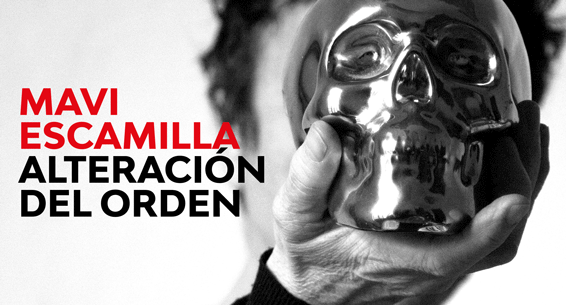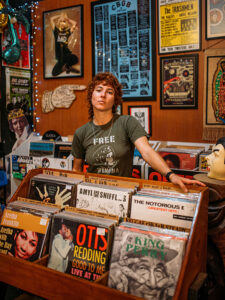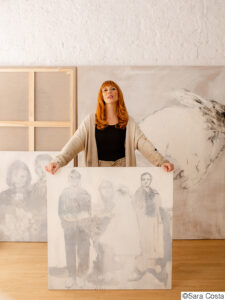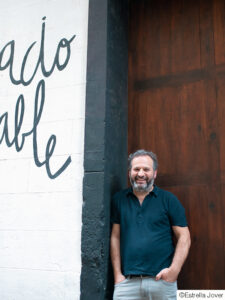
2017 It has been the year of emergence of the illustrator Ana Peñas. In Valencia we knew her well for her collaborations with the magazine Bostezo, Hit with tits and the fanzine Arròs Negre, and for his illustrations for the Turia beer campaign about the city's grocery stores, but the matter began to get big in 2016 with the VII Ibero-American Catalog Ilustra prize awarded by the Guadalajara International Book Fair (Mexico) and the Fnac-Salamandra Graphic International Graphic Novel Award. From there was born the wonderful We are all fine, in which he portrays with simplicity and tenderness the past and present lives of his two grandmothers, Maruja and Herminia. But getting ahead of Salamander, the young Valencian publishing house Barlin Libros was already working with her on the publication of a project that draws with a critical spirit the sacrosanct Spanish transition: In transition, the first book to treat this period in an illustrated way. We talked to her about illustration, of politics in the broadest sense of the word and of grandmothers.
In transition It is a book that is not at all complacent about the idolized Spanish Transition.. You draw a society that threw itself into the arms of “progress” (construction, turismo…) and forgot to heal bleeding wounds from the recent past. And you also link that “carelessness” with other conflicts that have come later.. What do you think were the main mistakes of the Transition?? What consequences do these errors have today??
The Transition was incapable of closing wounds from the past because at a structural level there was no real change. There were understandable aspects. For example, there is a vignette (that of Francoism), in which I decided to focus on the educational aspects of the period. And it is that, It lasted no less than forty years! What remains in the collective imagination after four decades of uninterrupted slogans? There is a term that is “sociological Francoism”, which refers to that mass of population that after the Dictatorship, and without recognizing himself as a Francoist politically, perpetuated in one way or another many of his own behaviors and attitudes. That's why I say that many things are understandable to a certain extent by then.. However, What we seek to criticize here are not those attitudes inserted in the DNA by an educational system, but the speech that in retrospect It has been built on the historical moment of the Transition. In one fell swoop everything has become unproblematic, implying that it was a peaceful and exemplary process, when in reality it was full of conflicts and many of the demands of many social groups were swallowed up by a new system that reproduced many of the operating schemes of what was theoretically being “left behind.”.
The image of the great buildings built on the skeletons of the defeated is very powerful... Can you translate that illustration into words??
It is building something new on completely unstable foundations.. Spain is the second country in the world for missing people (only Cambodia beats us). What more can be said in this regard? There is a considerable part of the political class that is not interested in giving dignity to all those dead. Those on the winning side have already been widely remembered. (for sample, the grandiose monument of The Valley of the Fallen). And in contrast, There are still hundreds of thousands of people from the other side in the ditches. What democracy is this?? The scheme of the two Spains is reproduced in a totally symbolic way... And that forgetfulness, that you want to establish at the political level, is “less worrying”: The worrying thing is that there is a society that shares and reproduces this intention to forget..
One of the claims from that time that appears in the book, that of “we demand the cancellation of the clause that allows rent increases”, It seems to make more sense now than before...
Yeah. Actually, The graffiti that you can see throughout the book are totally real from the time. To do so, I documented myself extensively., and I already tell you: I found all the ones you can see in photographs from then.. I do not know: there may be cyclical themes, that come and go.
You work on some faces with photographic images that make us instantly recognize characters like Gloria Fuertes, Arias Navarro or Salvador Puig Antich. What are you looking for with this resource??
The intention of the book in this sense is clear.. We sought to exalt the role of the street and society, against “official policy”. This is just a backdrop. Normally these types of stories are told backwards: It's politics (“grand politics”) the one that sets the course of the story, and everything else follows her. We have done it the other way around in a totally conscious way: the street is what sets the pace. The rest is just scenery; context.

You discuss the issue of housing, education, heroin, evictions or the 15M movement to build a critical account of the recent history of Spain. In your book it is clear that the social is political.
Fully. What's more political than a group of people demanding something?? From a liberal point of view, Only that which is framed within official channels is political.; within the party structure, unions or organizations within the system. It is an interested vision, of course. And a vision that is sold to us since we are born. In that way, claims outside that scheme lose legitimacy. But from the moment we decided to go shopping at the neighborhood grocery store instead of a large supermarket, we are doing politics. And this may be a somewhat naive example.. But from that idea you can extrapolate it to everything else. “The personal is political”, appropriating one of the most characteristic slogans of the feminist movement. The social of course it is. The collective, be it by any means, it is.
There are many group illustrations because, for better or worse, the history of a country is written as a whole. And as we see in the final vignette, Future changes will only be achieved collectively. Are you optimistic about what is to come?? What relationship does this vignette have with recent events in Catalonia??
I can't tell you I'm optimistic right now., the truth. When Alberto and I conceived the first draft of the book, the last vignette was going to be mobilizing. We wanted it to somehow appeal to the idea that you have to be active, mobilize… This was in the summer of 2016: The political and social context then was very different. In July 2017, however, when the book was almost closed, I spoke with Alberto and told him that I didn't feel like closing the book that way.. It seemed unreal to me at that point.. He agreed with me. And so, That closure was in the air until practically a week before the book went to press.. We didn't know how to close it... It was while we were in Buenos Aires, in a talk by one of the mothers of the Plaza de Mayo, when it occurred to me. At that time, Catalonia was also in the air.. everything helped. So I thought: “We have to sit down and really talk”. And not only that, because with that vignette I also want to imply that we should not make the mistakes of the past, when official policy absorbed the social demands of the street, and ended up deactivating that critical mass of the base (especially during the PSOE stage). Therefore, has a double reading.
Do you feel comfortable with the label of “committed customs”?
I find it difficult to define my work in a label, I wouldn't want to pigeonhole myself., I prefer to think that at any time I can approach projects from another point of view.. But I understand that taking into account my three published works, my proposal can be defined with that label.
We find even more customs in We are all fine where you tell the story of your two grandmothers. The interior of your grandmothers' houses are very recognizable., underwear, roadside bars... What attracts you to these settings?
What I find about these scenarios is the symbolic value they provide.. when you draw, you are very aware of why you are placing a character in a context, there is a prior decision. These objects and places not only serve me to portray my grandmothers and accompany their story., but also to generate a broader story that speaks of his generation, of their role as women and how political and social changes are reflected in these contexts.
It is not common to see elderly people starring in fictions, much less if they are women. Why do you think it is important?
I consider that there is a generation of old men and women in Spain who do not seem to be so “interesting” to star in fictions given that they do not have as much to do with heroic life stories., but rather resistance or even resignation: those who were children in the war, who did not fight on the front but who grew up with the war and the post-war period as a backdrop, They were educated in the most cruel and repressive Franco regime, who married and had children within the regime. If we also add the fact of being women, having spent most of their time locked in the domestic space, in the care role, This invisibility is even greater. Not rescuing their stories is to remain lame in our understanding as a society and in our debt to them..

The characters of Maruja and Herminia are very different. It is clearly seen in the telephone conversation that the two have. Can you describe them in general terms like this??
My grandmother Maruja is a woman who has a very strong character but with a very bitter feeling towards life.. He is one of those people who always looks at the negative side of things., that it is very difficult for him to be happy. It's very hard to say this about someone you love very much., but it is something that is very obvious with little that you know about it. The attempt to understand the bitterness of my grandmother Maruja was the seed of this project, From this need for empathy arises We are all fine. On the contrary, My grandmother Herminia has a very charismatic character, She is a very happy and open-minded woman if you compare her to other women of her generation.. This difference in character not only has to do with personality issues., but with the contexts in which they were raised. My grandmother Herminia lived in a much less repressive environment.
We are all fine It shows us how important the appearance of the washing machine was to free women from a task that consumed a lot of time in their lives., or the freedom that having a driver's license provided. Details that are rarely focused on…
Totally agree. These “details” arise from the anecdotes that they highlighted to me when I asked them about their lives.. That is why I later gave them prominence, because they had done it. For me it was a great history lesson.: the one that is written in lower case, which does not appear in textbooks but which speaks more about the changes in a society.
Of course, machismo permeates the book from beginning to end. For example, when you talk to Herminia about how sexuality was approached at the time. Were they aware of machismo?? Are they now?
I think that at that time they were not aware of machismo because the context was so endogamous that there was no one to compare themselves with.. As they have seen their sons and daughters grow, They have been able to compare it with their own experiences and I think that there, part of the machismo that they had to live has become evident.: the fact of not being able to get a divorce in the case of my grandmother Maruja, or being economically dependent, These are things that I have talked about with them since I was little.. But we are all products of our time, no matter how much they see that we have a very different life from theirs and judge it as positive changes towards women, It does not mean that their mentality has been able to change with the context.














